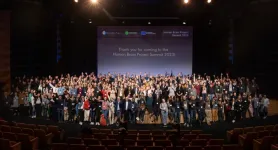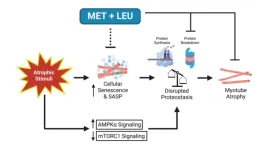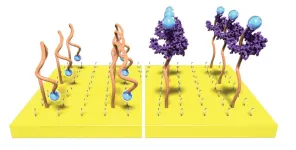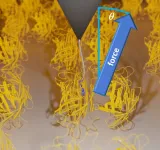(Press-News.org) The ten-year European Flagship Human Brain Project (HBP) links brain research with computing and technology in a large-scale, interdisciplinary approach. During the HBP Summit, researchers presented the abundant scientific achievements of the project and the legacy that it will leave for the research community. With the project approaching its conclusion in September 2023, a focal point of the final HBP Summit in Marseille was the discussion of the future of digital brain research.
One of the lasting contributions of the project is the research infrastructure EBRAINS, which provides open access to advanced technologies, tools, data and services for brain research and will remain available to the scientific community beyond 2023. During the four-day summit, scientists from all over Europe demonstrated how EBRAINS has already advanced their research.
“Work that took me two days in the past now takes me only ten minutes,” said neuroscientist Nicola Palomero-Gallagher from Forschungszentrum Jülich and the University of Düsseldorf. “I work with the human brain atlas on EBRAINS, which includes enormously large data – highly resolved digitized sections of the brain – that you cannot just handle on your normal laptop. You need supercomputers. In the past, these haven’t been easy to access. Now, this has really been simplified, and I can access and work with the data from anywhere in the world – and so can any researcher in brain science!”
The Human Brain Project has had a fundamental impact on the way brain research is carried out. A strong network of interdisciplinary researchers has formed to study the complexity of the human brain in a large-scale collaborative effort. During the Summit, which was also attended by many researchers from outside the HBP, it became clear that this network over the years has grown far beyond the boundaries of the project. “There is an opening towards the community,” said HBP researcher Viktor Jirsa from Aix-Marseille University, local host of this year’s Summit, during the panel discussion about the future of neuroscience. “A project, by definition, always has a beginning and an end, but what we are seeing now at the end of the Human Brain Project is continuing,” Jirsa said regarding the collaborative approach.
“We have all come out of our silos,” commented neuroscientist Stephanie Forkel from Radboud University in the Netherlands during the panel, which included representatives of large research initiatives from Japan, the US, Canada and Europe, who all stressed the importance of international collaboration for the future advancement of brain research.
The discussion about the future of neuroscience, which culminated at the HBP Summit this week, had already begun months earlier: In a collaborative effort, 98 researchers from 16 countries drafted a position paper outlining a common vision for the future of digital brain research. The paper had been initiated by a group of scientists of the Human Brain Project and put up for discussion on the platform Zenodo. Comments from many researchers around the world were integrated over time. Around one third of the authors of the most recent version are from outside the HBP community. “The idea of our vision paper was precisely to open up this discussion and make it fully inclusive. It is important to go beyond the HBP community and capture all the elements of future digital brain research,” said Katrin Amunts, Scientific Research Director of the HBP.
The latest version of the paper “The coming decade of digital brain research – A vision for neuroscience at the intersection of technology and computing” has been published shortly before the Summit, and an executive summary of the paper was handed over to the Directorate‑General for Communications Networks, Content and Technology of the European Commission during the event.
“The open community discussions showed us quite clearly where many of the major developments and needs of brain research converge at this point in time,” said Katrin Amunts. “Our paper describes the areas of research that we see for the coming years, the needed instrumentation and the central opportunities.”
“In the Human Brain Project, we pioneered connecting neuroscience with digital technologies on a very large scale to investigate the complexity of the human brain,” Katrin Amunts said. “Major achievements have come out of this approach, like world-leading 3D brain atlases, breakthroughs for personalized medicine based on computational brain modeling, brain-derived AI and computing that provides a new path for technology, and many more. These are advances to be further built upon.”
“A systematic approach will be essential to meet the pressing medical and technological challenges of the coming decade,” said Katrin Amunts.
Further links:
Final Human Brain Project Summit - Achievements and future of digital brain research
https://digital-strategy.ec.europa.eu/en/news/final-human-brain-project-summit-achievements-and-future-digital-brain-research
Booklet and Spotlight Brochure on HBP scientific advances
https://www.humanbrainproject.eu/en/science-development/scientific-achievements/brochures
END
Final Human Brain Project Summit closes with a vision for the future of digital brain research
2023-04-01
ELSE PRESS RELEASES FROM THIS DATE:
Metformin & leucine prevent cellular senescence & proteostasis disruption
2023-03-31
“Cellular senescence and disrupted proteostasis induced by myotube atrophy are prevented with low-dose metformin and leucine cocktail.”
BUFFALO, NY- March 31, 2023 – A new research paper was published on the cover of Aging (listed by MEDLINE/PubMed as "Aging (Albany NY)" and "Aging-US" by Web of Science) Volume 15, Issue 6, entitled, “Cellular senescence and disrupted proteostasis induced by myotube atrophy are prevented with low-dose metformin and leucine cocktail.”
Aging coincides with the accumulation of senescent cells within skeletal muscle that produce inflammatory products, known as the senescence-associated secretory ...
Plastic transistor amplifies biochemical sensing signal
2023-03-31
Molecules in our body send faint biochemical signals when health issues arise
New technology boosts these signals by 1,000 times
New approach paves way for sensing signals in real-time in the body without sending blood or saliva samples to a lab
EVANSTON, Ill. — The molecules in our bodies are in constant communication. Some of these molecules provide a biochemical fingerprint that could indicate how a wound is healing, whether or not a cancer treatment is working or that a virus has invaded the body. If we could sense these signals in ...
Childhood asthma declines during COVID-19 pandemic
2023-03-31
Half as many children in the United States were diagnosed with asthma in the first year of the COVID-19 pandemic compared to previous years, and Rutgers researchers think fewer colds may be part of the reason.
In a new Rutgers study, published in Respiratory Research, researchers examined the rates of new asthma diagnoses in a large commercial insurance claims database during the first year of the pandemic compared with rates of new diagnoses during the previous three years.
Using the Health Core Integrated Research ...
Study shows ketamine could be beneficial for treating brain injury in children
2023-03-31
A common anesthesia drug could be beneficial in reducing pressure inside the skull of children with traumatic brain injuries (TBI), according to a study published in Critical Care Medicine.
Ketamine, a drug that has been used for anesthesia since the 1970s, has traditionally been avoided for patients with TBI due to early studies suggesting that it could raise the pressure inside of the skull, known as intracranial pressure (ICP).
More recent studies have suggested otherwise, said lead author Michael Wolf, MD, assistant professor of Pediatrics and Neurological ...
Yak milk consumption among Mongol Empire elites
2023-03-31
Photos
For the first time, researchers have pinpointed a date when elite Mongol Empire people were drinking yak milk, according to a study co-led by a University of Michigan researcher.
By analyzing proteins found within ancient dental calculus, an international team of researchers provides direct evidence for consumption of milk from multiple ruminants, including yak. In addition, they discovered milk and blood proteins associated with both horses and ruminants. The team's results are published in Communication Biology.
The study presents novel protein findings from an elite Mongol Era cemetery ...
Hope for salamanders? Illinois study recalibrates climate change effects
2023-03-31
URBANA, Ill. – For tiny salamanders squirming skin-to-soil, big-picture weather patterns may seem as far away as outer space. But for decades, scientists have mostly relied on free-air temperature data at large spatial scales to predict future salamander distributions under climate change. The outlook was dire for the mini ecosystem engineers, suggesting near elimination of habitat in crucial areas.
Now, University of Illinois researchers are tuning into the microclimates that really matter to the imperiled amphibians and forecasting a somewhat more hopeful future.
“The ...
Engineered E. coli delivers therapeutic nanobodies to the gut
2023-03-31
BOSTON-- Humans are colonized with thousands of bacterial strains. Researchers are now focused on genetically modifying such bacteria to enhance their intrinsic therapeutic properties.
One goal is to develop smart microbes that release therapeutic payloads at sites of disease, thus maintaining therapeutic efficacy while limiting many of the side effects that can be associated with the systemic administration of conventional drugs.
Investigators at Massachusetts General Hospital (MGH), a founding member of Mass General Brigham (MGB), have engineered a strain of the probiotic Escherichia ...
New type of friction discovered in ligand-protein systems
2023-03-31
An interdisciplinary research team of the Institutes of Physical Chemistry and Physics of the University of Freiburg and the Max Planck Institute of Biophysics in Frankfurt-am-Main has discovered a new, direction-dependent friction in proteins called anisotropic friction. “Until now, nobody had observed that friction in biomolecules was dependent on direction,” says physicist Dr. Steffen Wolf of the University of Freiburg. The results have been published as cover story in the scientific journal “Nano Letters.”
Experiments on model complex of protein-ligands
Proteins constitute the microscopic machinery of cells. They perform work during their functional cycles. Accordingly, ...
New UNC Chapel Hill study quantifies $562M in financial risk from Hurricane Florence using novel modeling approach that evaluates risk of mortgage default and property abandonment
2023-03-31
When Hurricane Florence made landfall on North Carolina’s coast in 2018, it brought record rainfall causing catastrophic flooding and damages to communities across the eastern portion of the state.
Estimating the financial impacts of household flooding is complex because direct damages often snowball into other financial risks, like a decrease in property value or loss of equity. Generally, post-disaster damage assessments focus on insured and uninsured losses, but these numbers do not account for the secondary impacts to households, lenders, local governments and other stakeholders who may also share in the financial consequences if a property owner defaults ...
What is foreign exchange market or simply Forex?
2023-03-31
The Forex market, also known as the foreign exchange market or simply Forex (short for "foreign exchange"), is a decentralized global market where various currencies are traded. It is the largest financial market in the world, with a daily trading volume exceeding $6 trillion. The primary purpose of the Forex market is to facilitate international trade and investment by allowing businesses, governments, and individuals to convert one currency into another.







